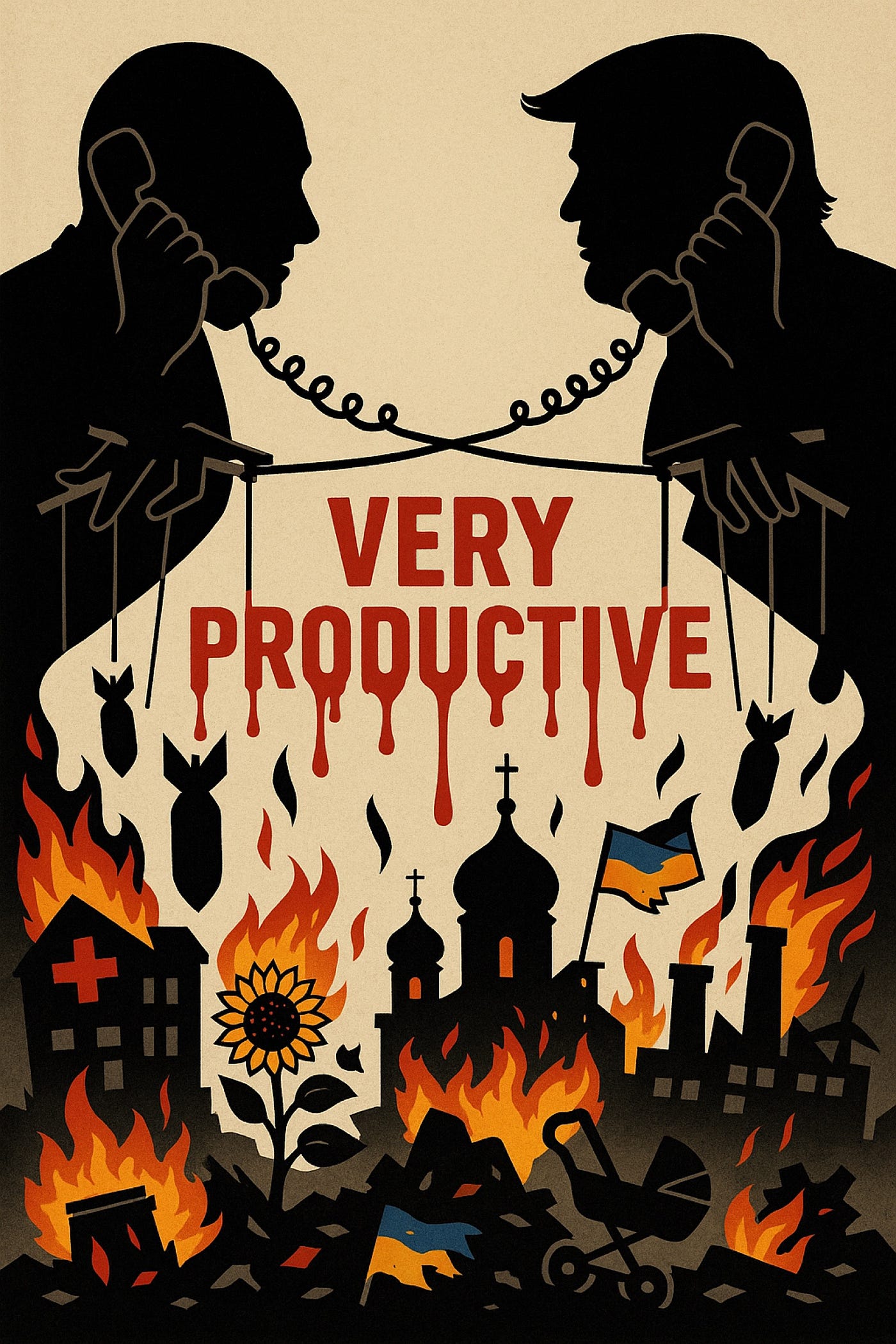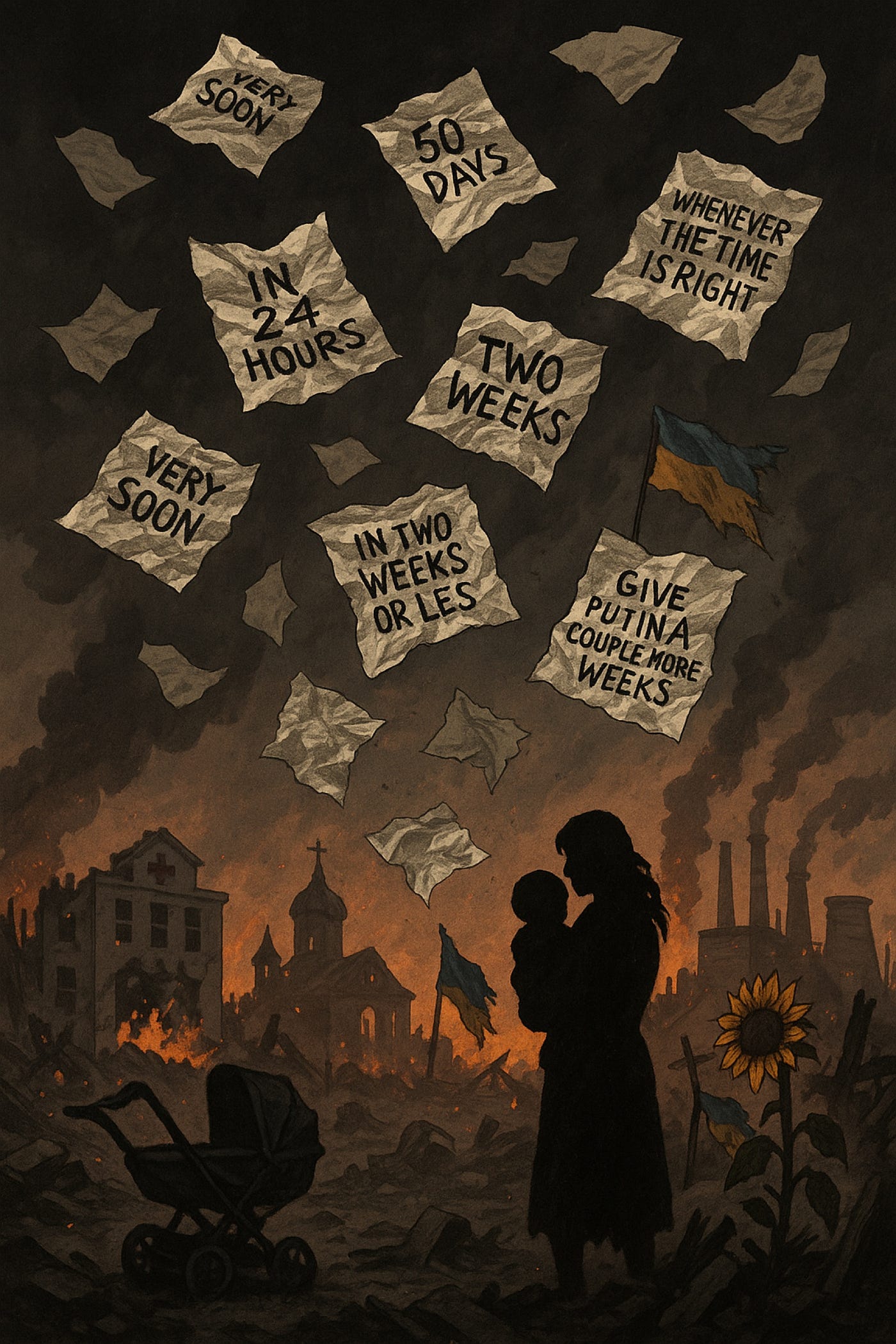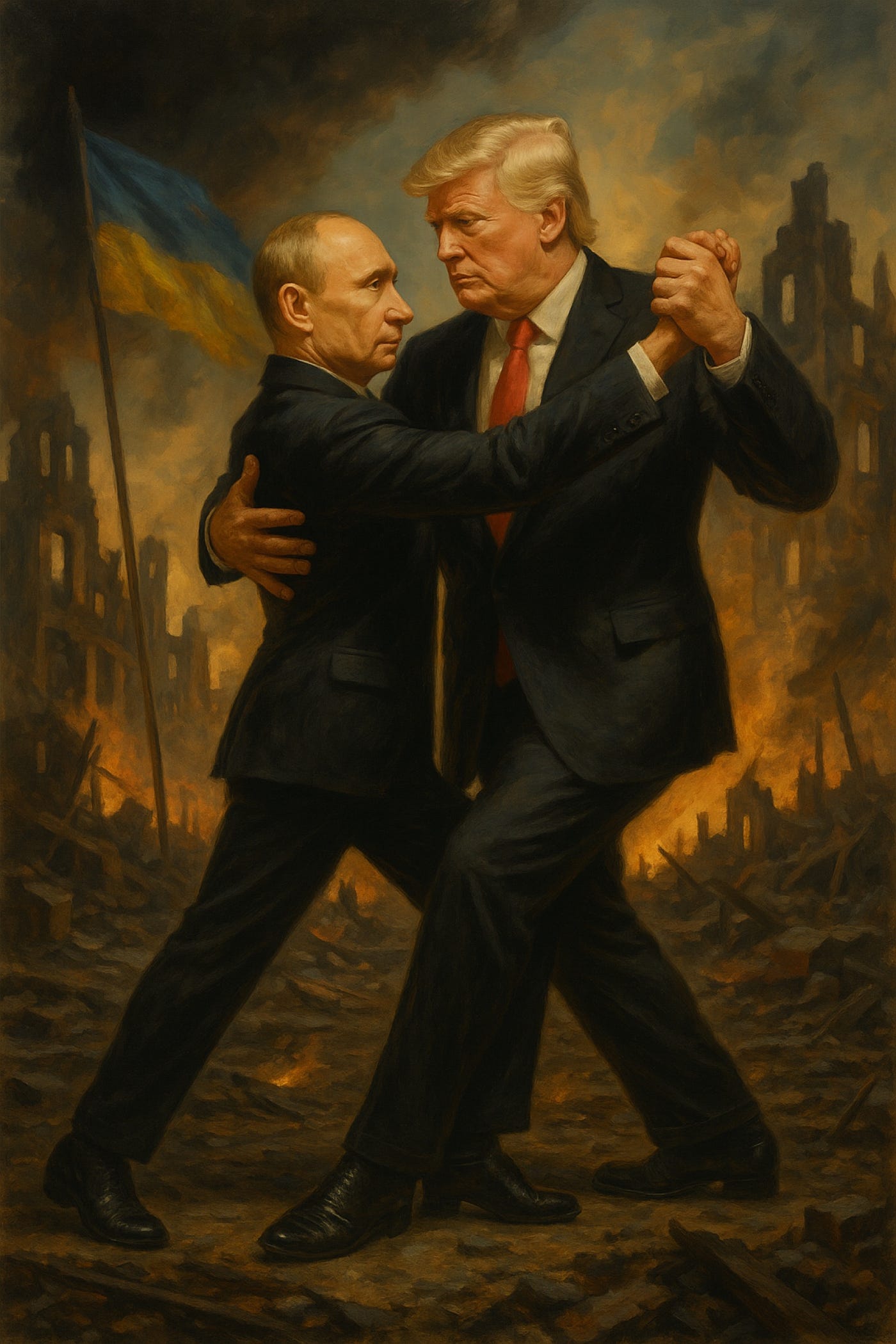*原文链接:https://medium.com/@giorgioprovinciali/trump-and-putin-are-tangoing-on-the-ashes-of-ukraine-b88a20eef4f6?sk=92e9300b9b08ea51acebce6d377571ff
感激您重视我们为提供真实的、第一手战场信息所做的努力,您可以通过支持我们的筹款活动来帮助我们购买反无人机“РЕБ”设备。
在过去的三年里,作为自由撰稿人,我们一直在乌克兰战争的所有前线进行报道,自从大规模…
https://www.paypal.com/pools/c/9jdpPchpGi
Trump and Putin Are Tangoing on the Ashes of Ukraine
By: Giorgio Provinciali
Live from Ukraine
If you value our efforts to deliver authentic, firsthand information from the field, you can support us by backing our fundraising campaign
Kyiv – Many news agencies report that shortly after landing in Washington, President Zelensky and his team were surprised to learn that the White House leader and the Russian dictator had agreed to meet in the next two weeks in Budapest, the European country least friendly to Ukraine. More than the contrast with the real, violent world around him, what’s surprising is Zelensky’s Voltairean candor.
Taking time is part of Putin’s strategy whenever he faces a problem. In this case, it’s the delivery of American Tomahawk missiles, but looking back at recent history, it’s easy to find notable examples of delays, promises of medium timeframes, or negotiations before acting – even and especially on his best asset in Washington.

As soon as he took office at the White House, after a «long and productive» phone call with Putin, Trump announced last February that he had agreed to begin negotiations «immediately» to end Russia’s war in Ukraine. Once all reasonable time had passed, «In two weeks or less» was the phrase he used on April 27 to reiterate the same point, later adding that «a little more time»might be acceptable.
Setting a short deadline but leaving some leeway is a pattern often repeated in Trump’s rhetoric.
«Give Putin a couple more weeks,» he said in a subsequent post that went viral on YouTube, to raise the possibility of a peace agreement while again postponing action. The «two weeks» leitmotif was used throughout the spring and summer as a window of opportunity to put tough decisions on hold, offering unacceptable proposals such as ceding Donbas in exchange for a freeze on the front lines. Seeing these absurdities rejected, Trump resortedto a further delaying ploy, outlining a months-long timeline for negotiations with Russia and explaining that an agreement could be reached within that long period.
Following smaller temporal patterns, at various other points he linked his decisions to Moscow’s response to alleged negotiations conducted without Ukraine, implying that he would not step on the accelerator until he saw progress. The most emblematic example was when he set a 50-day deadline last June for Russia to show progress before incurring «devastating American sanctions.» When pressured by an international community which was horrified by Russia’s resurgent bombing and crimes in Ukraine, Trump had shorten this ultimatum to «10–12 days,» complaining that no progress was being made.
After that deadline passed, Trump announced he would meet Putin in Anchorage on August 15 rather than impose the feared sanctions.

Vague statements like «Very soon» or «Whenever the time is right» have been made ad libitum, a consolidated and recurring practice to postpone operational decisions without specifying exactly what action would be taken or what prevented an immediate one. Other more or less peremptory deadlines («50 days,» «two weeks,» etc.) have, however, never been respected, proving themselves equally to be rhetorical tools rather than binding commitments.
Setting a deadline, letting it pass, and then announcing a meeting or negotiation as the next move is a classic tactic that Moscow and Washington have long used. Trump himself never misses a chance to say that «it takes two to tango.» Except that it’s him and Putin who are tangoing on the ashes of Ukraine.

特朗普与普京在乌克兰的灰烬上共舞
作者:Giorgio Provinciali
来自乌克兰的现场报道
基辅—据多家新闻机构报道称,泽连斯基总统及其团队抵达华盛顿后不久,即惊讶地得知白宫领导人与俄罗斯独裁者已同意在未来两周内在布达佩斯会面,在那个对乌克兰最不友好的欧洲国家。除了与他周围真实、暴力的世界形成对比之外,更令人惊讶的是泽连斯基伏尔泰式的坦率。
每当普京遇到问题时,拖延时间是他所采取的策略之一。这次的情况是美国“战斧”导弹的交付。回顾最近的历史,很容易找到延迟、承诺中期时间表或在行动前进行谈判的显著例子—甚至尤其是他在华盛顿的最佳资产上的例子。
(图:AI-制作图片)
特朗普入主白宫后不久,在与普京进行了“漫长而富有成效”的通话后,于2月底宣布,他已同意“立即”开始谈判,以结束俄罗斯在乌克兰的战争。一经所有合理的期限过去,他便在4月27日再次使用“两周或更短的时间”这一措辞来故伎重演,之后又补充说“再多一点时间”也许是可以接受的。
设置一个短暂的截止日期,但又留下一些余地,是特朗普言辞中经常重复出现的模式。
“再给普京几周时间,”他在随后的帖子中说,该帖子在 YouTube 上疯传,以提高和平协议的可能性,同时再次推迟行动。“两周”的主题贯穿整个春季和夏季,作为搁置艰难决定的机会之窗,提供了不可接受的提议,例如割让顿巴斯以换取前线冻结。看到这些荒谬提议被拒绝后,特朗普采取了进一步的拖延策略,提出了与俄罗斯谈判的数月的时间表,并解释说可以在这么长的时间内达成协议
继数个短暂期限后,他在各个其他时间点将他的决定与莫斯科在没有乌克兰的情况下进行的所谓谈判的回应联系起来,暗示在他看到进展之前,他不会踩油门。最具代表性的例子是,今年6月,他设定了50天的最后期限,让俄罗斯在遭受“毁灭性的美国制裁”之前展示进展。当受到国际社会对俄罗斯死灰复燃的轰炸和在乌克兰犯下的罪行感到震惊的压力时,特朗普将最后通牒缩短为“10-12 天”,抱怨说没有看到任何进展。
在该截止日期过后,特朗普宣布他将于 8 月 15 日在安克雷奇会见普京,而不是实施严厉的制裁。
(图:AI-制作图片)
像“很快”或“当时机成熟时”这样的模糊说辞就是随意提出的,这是一种综合和反复的做法,用于推迟行动决策,而不具体说明将采取何种行动或阻止立即采取行动的原因。 其他或多或少具有强制性的截止日期(“50 天”、“两周”等)从未得到尊重,证明它们同样是修辞工具,而不是具有约束力的承诺。
设定截止日期,让其过去,然后宣布会议或谈判是下一步行动,这是莫斯科和华盛顿长期以来使用的经典策略。特朗普本人从不错过任何机会说“探戈需要两个人跳” (共同责任)。只是这次是他和普京在乌克兰的灰烬上跳探戈。
(图:AI-制作图片)